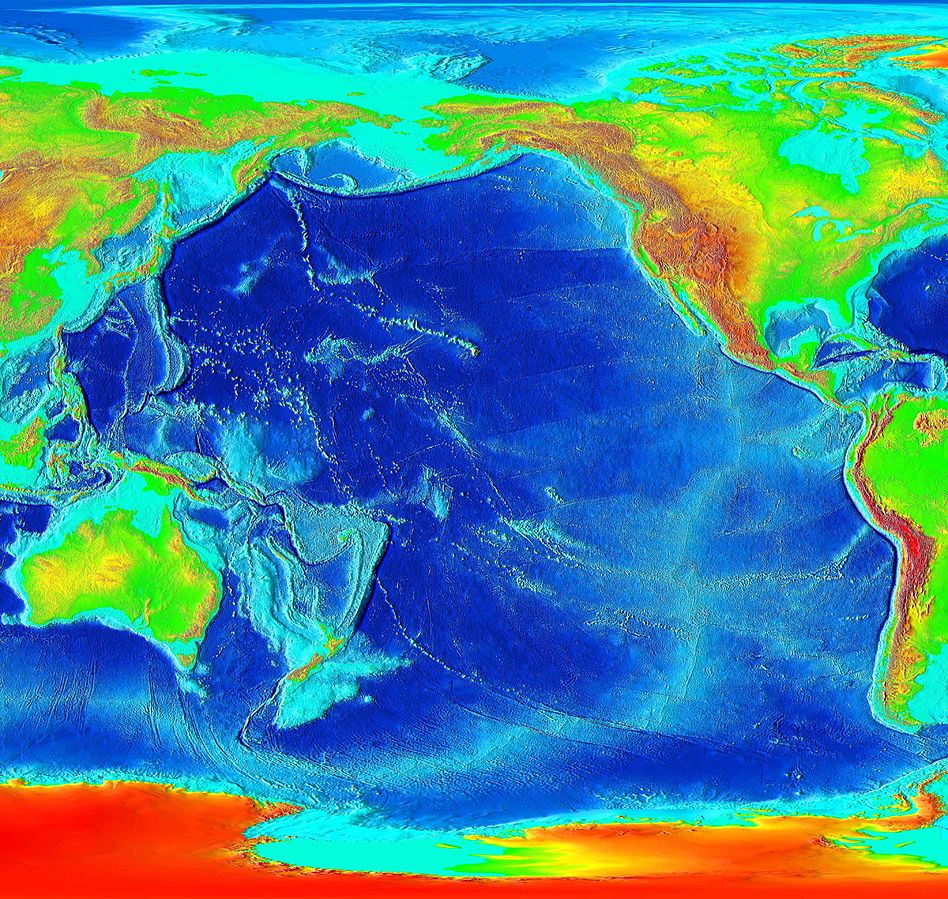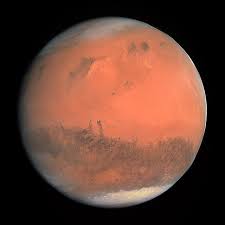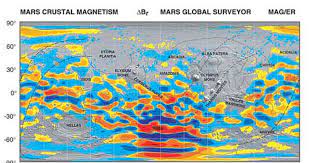
There are good reasons to think that Earth and Mars originally formed a single planet outside the orbit of Jupiter. At some early point in Solar System history, Jupiter’s powerful gravitational field pulled this planet past the gas giant. As it neared Jupiter, tidal friction heated it to the melting point, and Jupiter tore Mars away from Earth, leaving the Pacific Basin and an array of evidence on both planets. Earth and Mars then sped off into the inner solar system.
originally formed a single planet outside the orbit of Jupiter. At some early point in Solar System history, Jupiter’s powerful gravitational field pulled this planet past the gas giant. As it neared Jupiter, tidal friction heated it to the melting point, and Jupiter tore Mars away from Earth, leaving the Pacific Basin and an array of evidence on both planets. Earth and Mars then sped off into the inner solar system.
In 1892, following George Darwin’s fission theory of the origin of the Moon, geophysicist Osmond Fisher argued that the Pacific Basin was a scar left over by the separation of the Moon from a rapidly rotating Earth. But according to the new theory, Mars separated from Earth at 25º N, 153º E, displacing the geomagnetic field 498 km off center in the direction of the Pacific Basin. The skew of the geomagnetic field, the seismically active Ring of Fire, the Andesite Line, and the Hawaiian and South Pacific hotspots are leftovers. So, too, is the South Atlantic Magnetic Anomaly on the opposite side of the world. The Van Allen radiation belt comes close to Earth as a consequence of the skew in the geomagnetic field.
Given plate tectonics and continental drift, the Pacific Basin has presumably changed considerably since its origin in the Mirovia Ocean, later Panthalassic Ocean. According to this theory, none of the changes in configuration over billions of years destroyed the underlying Ring of Fire formed by the emergence of Mars.
Seismic anisotropy1 reveals a unique pancake-like pattern at 160 km depth, approximately centered on the island of Hawaii. This is consistent with an emergence of Mars, though this location would not necessarily have been the epicenter of the cataclysmic event. The South Pacific contains many features in keeping with an emergence. In fact, a Mars exit would have left a gaping wound in Earth. Mars could have torn off in such a way that the gash was oval instead of circular and extended far to the south.
The Pacific Basin contains features suggesting an emergence of Mars. In a list of hotspot/melting anomaly locations, Pacific hotspots score much higher in flow rate than Atlantic and Indian Ocean counterparts. Only the hotspots at the near edges of the adjacent Nazca and Australian plates match them.2 The 1-km high Hawaiian swell and the 500-m high South Pacific Superswell also mark the Pacific Basin as idiosyncratic. If seismographic slowness is evidence of higher heat, the South Pacific Superswell stands over a hot area of the mantle that extends down to the core.3 Volcanism in various South Pacific hotspots also varies from the normal Mid-Ocean Ridge basalts of the Atlantic. It has higher vesicularity, more blocky/tabular flows and hornitos made of silica-enriched lava, and extreme end-members of radiogenic isotopes. Indeed, these are extreme versus any isotopes in their class worldwide.4 In some areas of the South Pacific, the lithosphere is significantly thinner than usual. Regular or intermittent pulses of magma appear to move upward from the mantle rapidly through a weakened lithosphere to erupt undersea or above sea surface.5 The trenches and troughs surrounding the Pacific are the deepest in the world. In particular, the Mariana Trench appears to have been formed by an unusual cataclysm.
Unique Patterns
Two unique patterns encircle the Central Pacific. The first is the anomalous Andesite Line, the boundary between the mafic mantle rock of the Central Pacific and the andesitic crustal rock that surrounds it.6 Indonesia, the Philippines, Japan, New Guinea, and New Zealand lie outside the Andesite Line. Why should this distinction exist in the first place? The pattern would clearly match a central zone of mafic rocks pulled from the mantle during the emergence of Mars, surrounded by an andesitic crust. The second pattern is the Ring of Fire, the unique zone of dynamic seismic and volcanic activity around the Pacific rim. The Andesite Line fits inside of the Ring of Fire, so in effect they form a double ring, a third pattern, again without an equivalent worldwide. Plate tectonics doesn’t explain why there is a double-ring pattern, why there are mafic and andesitic zones, and why the Ring of Fire has such an egregious shape and such activity.
In contrast, the perception that Jupiter’s gravity tore Mars out of the Pacific Basin makes perfect sense of these three patterns. The Andesite Line and the Ring of Fire form great ancient scars on the Earth’s surface. Plate tectonics interacts with them (less with the Andesite Line), but they remain patterns that go back billions of years. The notion that plate tectonics erases the entire Pacific floor every 170 million years does not take account of the special characteristics of the Andesite Line and the Ring of Fire. The anomalies beneath them extend deep into the mantle.
Researchers reported the Ring of Fire in the 19th century and the Andesite Line in 1912, independently of the later theory of plate tectonics. The inability of plate tectonics to explain their unique natures has drawn little attention. While the Andesite Line quietly demarcates an anomalous boundary not conforming to plate tectonics, it receives far less publicity than the Ring of Fire. But it is actually more useful evidence of the emergence of Mars than the Ring of Fire because it is harder to discuss in terms of plate tectonics. These ancient scars represent an important limit of the theory of plate tectonics. Scientists need to avoid overusing its flexibility to explain too much; in that sense, it resembles the protean models of the Giant Impact hypothesis of the formation of the Earth-Moon system.
Unlike with the Moon, which has a 1:81 ratio of mass to that of the Earth,  Mars has a mass of a 1:9.5 ratio to that of the Earth, which corresponds roughly to the size of the Pacific Basin. Meanwhile, the reversed polarity magnetic stripes of the southern hemisphere of Mars remarkably resemble the magnetic stripes of the Earth’s seabed divergence zones. In effect, the southern hemisphere of Mars is the original surface (now battered by impacts) of the Pacific Basin.
Mars has a mass of a 1:9.5 ratio to that of the Earth, which corresponds roughly to the size of the Pacific Basin. Meanwhile, the reversed polarity magnetic stripes of the southern hemisphere of Mars remarkably resemble the magnetic stripes of the Earth’s seabed divergence zones. In effect, the southern hemisphere of Mars is the original surface (now battered by impacts) of the Pacific Basin.
Thus this theory provides fitting solutions for four otherwise poorly explained anomalies of the Pacific Basin: the skew of the geomagnetic field; the uniquely hot and flowing tectonic regime beneath the Central and South Pacific; the size, shape, and unusually dynamic seismic and volcanic activity of the Ring of Fire; and the Andesite Line. It also resolves three otherwise poorly explained anomalies of Mars: reversed magnetic striping matching that of the Pacific Basin on a planet without a magnetic dynamo; a much lower mass than Earth and Venus; and the Great Dichotomy between north and south. It also accounts for the anomalous amount of water in Mars’ past as well as the significant amount of water on Earth. 4 + 3 + 2 = 9 resolved anomalies. Of the Pacific anomalies, the Andesite Line seems the most telling. Of the Martian ones, the reversed magnetic striping is clearly the most telling.
So Osmond Fisher was right to perceive that the Pacific Basin was an ancient scar resulting from a cataclysmic event, while the torn-off mass formed a nearby celestial body. Rejected old theories sometimes contain precious insights.
Contrary to common assumption, the Pacific-Mars theory shows that Earth originated in the outer solar system.7 The Pacific-Mars theory is a component of the broader theory The Outer Solar System Origin of the Terrestrial Planets.
*****
Kenneth J. Dillon is a historical and scientific researcher. See the biosketch at About Us. His novel of discovery science Rosemarie contains a resolution of the controversy over the Venus theory of Immanuel Velikovsky.

